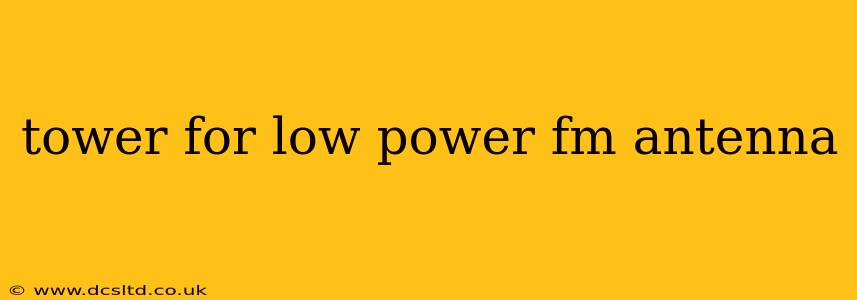Choosing the right tower for your low-power FM antenna is crucial for optimal broadcast range and signal quality. The height and structural integrity of your tower directly impact your station's reach and listener experience. This guide delves into the key factors to consider when selecting a tower, addressing common questions and concerns.
What Height Tower Do I Need for My Low Power FM Antenna?
The ideal height for your FM broadcast tower isn't one-size-fits-all. It depends on several factors, including:
- Effective Radiated Power (ERP): Higher ERP allows for a greater broadcast range, potentially reducing the need for an extremely tall tower. Conversely, lower ERP might necessitate a taller tower to achieve satisfactory coverage.
- Terrain: Hilly or mountainous terrain will require a taller tower to overcome obstacles and reach listeners in valleys. Flat terrain allows for better signal propagation, potentially allowing for a shorter tower.
- Desired Coverage Area: Your target audience's geographical distribution will influence the required height. A larger coverage area generally necessitates a taller tower.
- Regulatory Requirements: Your specific location and licensing authority will have regulations regarding maximum tower height and other restrictions. Always consult your licensing body before making any decisions.
While there's no magic number, a good starting point for many low-power FM stations is between 30 and 100 feet. However, professional antenna engineers can conduct a propagation study to accurately determine the optimal height for your specific situation. This study factors in all the above variables to produce a highly accurate prediction of your broadcast range for various tower heights.
What Types of Towers Are Suitable for Low Power FM Antennas?
Several tower types are suitable for low-power FM antennas, each with its own advantages and disadvantages:
- Self-Supporting Towers: These towers stand independently and are commonly used for low-power FM applications. They are generally less expensive than guyed towers, particularly for smaller heights, but might require a larger base footprint.
- Guyed Towers: These towers are supported by guy wires anchored to the ground. They offer greater height for a given weight and cost less per foot than self-supporting towers, especially at greater heights. However, they require more ground space due to the guy wires and can be more complex to install.
- Rooftop Mounts: If your budget is tight and your location allows, a rooftop mount can be a cost-effective solution. However, this will severely limit your broadcast range.
The choice between these depends on the budget, available space, and desired height. Always consult a structural engineer to ensure the tower's stability and ability to withstand wind loads and other environmental factors.
What Materials Are Typically Used for Low Power FM Antenna Towers?
Common tower materials include:
- Steel: Steel is the most prevalent material due to its strength and relatively low cost. Galvanized steel offers added corrosion resistance, essential for outdoor applications.
- Aluminum: Aluminum is lighter than steel, offering advantages in certain situations, especially where transportation or installation is challenging. However, it is generally more expensive.
How Much Does a Tower for a Low Power FM Antenna Cost?
The cost of a tower varies significantly based on height, material, type (self-supporting or guyed), and any custom features. Prices range from a few thousand dollars for smaller, simpler towers to tens of thousands for taller, more complex structures. Remember to factor in installation costs, which can be substantial.
Are There Any Safety Regulations I Need to Follow When Installing a Tower?
Yes, absolutely. Tower installation involves significant safety risks. Always follow all local, state, and federal regulations regarding tower construction and safety. This includes obtaining necessary permits, adhering to safety standards, and potentially working with licensed professionals for installation and maintenance. Ignoring safety regulations can lead to serious injury or even death.
How Do I Maintain My Low Power FM Antenna Tower?
Regular maintenance is crucial to ensure the longevity and structural integrity of your tower. This includes:
- Regular Inspections: Conduct regular visual inspections for signs of corrosion, damage, or loosening of components.
- Professional Maintenance: Schedule periodic inspections by qualified tower technicians.
- Lightning Protection: Implement a proper lightning protection system to safeguard your equipment and prevent damage to the tower.
By carefully considering these factors and consulting with professionals, you can select the most suitable tower for your low-power FM antenna, ensuring efficient signal transmission and long-term reliability. Remember, prioritizing safety and regulatory compliance throughout the process is paramount.
